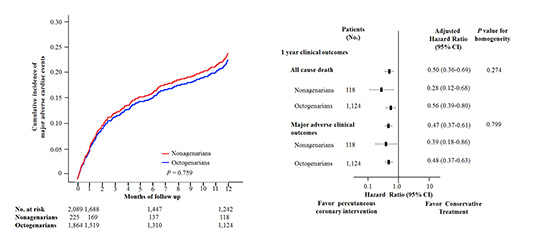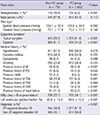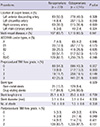1. Avezum A, Makdisse M, Spencer F, Gore JM, Fox KA, Montalescot G, Eagle KA, White K, Mehta RH, Knobel E, et al. Impact of age on management and outcome of acute coronary syndrome: observations from the Global Registry of Acute Coronary Events (GRACE). Am Heart J. 2005; 149:67–73.
2. Singh M, Rihal CS, Lennon RJ, Garratt KN, Mathew V, Holmes DR Jr. Prediction of complications following nonemergency percutaneous coronary interventions. Am J Cardiol. 2005; 96:907–912.
3. Lee PY, Alexander KP, Hammill BG, Pasquali SK, Peterson ED. Representation of elderly persons and women in published randomized trials of acute coronary syndromes. JAMA. 2001; 286:708–713.
4. Batchelor WB, Anstrom KJ, Muhlbaier LH, Grosswald R, Weintraub WS, O'Neill WW, Peterson ED. Contemporary outcome trends in the elderly undergoing percutaneous coronary interventions: results in 7,472 octogenarians: National Cardiovascular Network Collaboration. J Am Coll Cardiol. 2000; 36:723–730.
5. Floyd KC, Jayne JE, Kaplan AV, Friedman BJ, Niles NW, Hettleman BD, Robb JF, Thompson CA. Age-based differences of percutaneous coronary intervention in the drug-eluting stent era. J Interv Cardiol. 2006; 19:381–387.
6. Klein LW, Block P, Brindis RG, McKay CR, McCallister BD, Wolk M, Weintraub W. ACC-NCDR Registry. Percutaneous coronary interventions in octogenarians in the American College of Cardiology-National Cardiovascular Data Registry: development of a nomogram predictive of in-hospital mortality. J Am Coll Cardiol. 2002; 40:394–402.
7. Cohen HA, Williams DO, Holmes DR Jr, Selzer F, Kip KE, Johnston JM, Holubkov R, Kelsey SF, Detre KM. NHLBI Dynamic Registry. Impact of age on procedural and 1-year outcome in percutaneous transluminal coronary angioplasty: a report from the NHLBI Dynamic Registry. Am Heart J. 2003; 146:513–519.
8. Roberts WC, Shirani J. Comparison of cardiac findings at necropsy in octogenarians, nonagenarians, and centenarians. Am J Cardiol. 1998; 82:627–631.
9. Galioto A, Dominguez LJ, Pineo A, Ferlisi A, Putignano E, Belvedere M, Costanza G, Barbagallo M. Cardiovascular risk factors in centenarians. Exp Gerontol. 2008; 43:106–113.
10. Anderson JL, Adams CD, Antman EM, Bridges CR, Califf RM, Casey DE Jr, Chavey WE 2nd, Fesmire FM, Hochman JS, Levin TN, et al. 2012 ACCF/AHA focused update incorporated into the ACCF/AHA 2007 guidelines for the management of patients with unstable angina/non-ST-elevation myocardial infarction: a report of the American College of Cardiology Foundation/American Heart Association Task Force on Practice Guidelines. J Am Coll Cardiol. 2013; 61:e179–e347.
11. Lee KH, Jeong MH, Ahn YK, Kim JH, Chae SC, Kim YJ, Hur SH, Seong IW, Hong TJ, Choi D, et al. Gender differences of success rate of percutaneous coronary intervention and short term cardiac events in Korea Acute Myocardial Infarction Registry. Int J Cardiol. 2008; 130:227–234.
12. Cho Y, Yang HM, Park KW, Chung WY, Choi DJ, Seo WW, Jeong KT, Chae SC, Lee MY, Hur SH, et al. Paclitaxel- versus sirolimus-eluting stents for treatment of ST-segment elevation myocardial infarction: with analyses for diabetic and nondiabetic subpopulation. JACC Cardiovasc Interv. 2010; 3:498–506.
13. Cho KH, Jeong MH, Ahn Y, Kim YJ, Chae SC, Hong TJ, Seong IW, Chae JK, Kim CJ, Cho MC, et al. Low-density lipoprotein cholesterol level in patients with acute myocardial infarction having percutaneous coronary intervention (the cholesterol paradox). Am J Cardiol. 2010; 106:1061–1068.
14. Lee KH, Jeong MH, Kim HM, Ahn Y, Kim JH, Chae SC, Kim YJ, Hur SH, Seong IW, Hong TJ, et al. Benefit of early statin therapy in patients with acute myocardial infarction who have extremely low low-density lipoprotein cholesterol. J Am Coll Cardiol. 2011; 58:1664–1671.
15. Skolnick AH, Alexander KP, Chen AY, Roe MT, Pollack CV Jr, Ohman EM, Rumsfeld JS, Gibler WB, Peterson ED, Cohen DJ. Characteristics, management, and outcomes of 5,557 patients age > or =90 years with acute coronary syndromes: results from the CRUSADE Initiative. J Am Coll Cardiol. 2007; 49:1790–1797.
16. Teplitsky I, Assali A, Lev E, Brosh D, Vaknin-Assa H, Kornowski R. Results of percutaneous coronary interventions in patients > or =90 years of age. Catheter Cardiovasc Interv. 2007; 70:937–943.
17. Sakai K, Nagayama S, Ihara K, Ando K, Shirai S, Kondo K, Yokoi H, Iwabuchi M, Nosaka H, Nobuyoshi M. Primary percutaneous coronary intervention for acute myocardial infarction in the elderly aged ≥75 years. Catheter Cardiovasc Interv. 2012; 79:50–56.
18. Moreno R, Salazar A, Bañuelos C, Hernández R, Alfonso F, Sabaté M, Escaned J, Pérez MJ, Azcona L, Macaya C. Effectiveness of percutaneous coronary interventions in nonagenarians. Am J Cardiol. 2004; 94:1058–1060.
19. From AM, Rihal CS, Lennon RJ, Holmes DR Jr, Prasad A. Temporal trends and improved outcomes of percutaneous coronary revascularization in nonagenarians. JACC Cardiovasc Interv. 2008; 1:692–698.
20. Morrison DA, Bies RD, Sacks J. Coronary angioplasty for elderly patients with "high risk" unstable angina: short-term outcomes and long-term survival. J Am Coll Cardiol. 1997; 29:339–344.
21. De Gregorio J, Kobayashi Y, Albiero R, Reimers B, Di Mario C, Finci L, Colombo A. Coronary artery stenting in the elderly: short-term outcome and long-term angiographic and clinical follow-up. J Am Coll Cardiol. 1998; 32:577–583.
22. DeGeare VS, Stone GW, Grines L, Brodie BR, Cox DA, Garcia E, Wharton TP, Boura JA, O'Neill WW, Grines CL. Angiographic and clinical characteristics associated with increased in-hospital mortality in elderly patients with acute myocardial infarction undergoing percutaneous intervention (a pooled analysis of the primary angioplasty in myocardial infarction trials). Am J Cardiol. 2000; 86:30–34.








 PDF
PDF ePub
ePub Citation
Citation Print
Print








 XML Download
XML Download